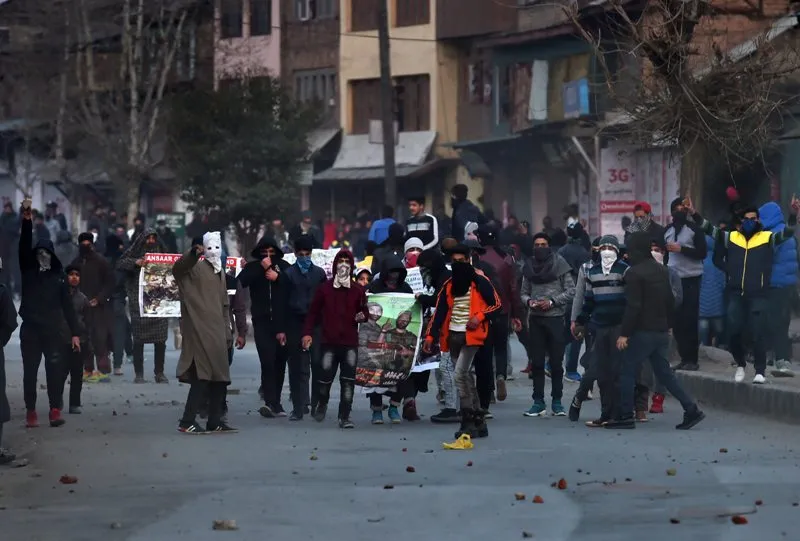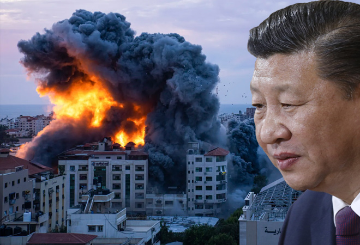
In Kashmir, terror outfits are carrying out an aggressive public relations strategy. The latest trend is to upload individual and group photographs of newly recruited militants on all available social media platforms. Two years after Burhan Wani showed the lethal impact of the internet by releasing the photograph of his gang, the Hizbul Mujahideen issued group photos of 14 new recruits in July. Just a week earlier, the outfit released individual images of
35 new terrorists.
Unlike the Burhan-gang who wore military fatigues, this new gang is dressed in blue clothes and their right hands raised with index fingers pointing towards the sky. This is how Osama bin Laden communicated with his followers and how the Islamic State propagates its ideology. All the images of new recruits released in the past few months have two common elements. All the pictures carry a caption mentioning the name and other important details about the new recruit. A majority of them have a copy of the Quran by their side. Like physical gestures, these photographs are powerful expression of political and social sentiments. Their weapons depict the confidence and power they possess. Index fingers pointed towards the sky represent the support of divine force for their cause and their oneness. Unmasked faces reveal their fearlessness and a sense of accomplishment.
All the pictures carry a caption mentioning the name and other important details about the new recruit.. Unmasked faces reveal their fearlessness and a sense of accomplishment.
In Kashmir’s e-jihad, these images have proven to be convincing, captivating and seductive. The moment they are released, they are circulated across the Kashmir Valley within no time. The precedent set by Wani of uploading glorifying images to declare one’s recruitment in the terror outfit has revolutionised Kashmir’s social communication network. In Kashmir’s daily life, the picture strategy has become the new currency. It has magnified the intensity of Kashmir’s ‘sufferings’ and lured vulnerable youth to pick up the gun by falling prey to a false sense of heroism. It has become an integral part of the conversations about Kashmir. It is, therefore, important to understand the new meanings conveyed by these images.
 A collage of screenshots from Facebook shows the photos in circulation.
A collage of screenshots from Facebook shows the photos in circulation.
This strategy is fast morphing into a cultural tradition, creating false narratives by camouflaging the truth with heroic tales of their fallen comrades and the radicalised new recruits. It is influencing the daily behaviour of the Kashmiri society, which is expressed through street rage, by graffiti eulogising the dead terrorists, multiple funeral processions of slain terrorists and mobs acting as human shields. This leaves very little room for the truth to emerge and narrate the other side of the story. Social media is writing a new chapter of Kashmir’s cultural transformation. How to respond to this is entirely up to the Kashmiri society, as much as it is up to the political leadership in Srinagar and New Delhi.
The picture strategy of Hizbul Mujahideen combined with the other methods of expression, when looked through the prism of storytelling, must be read on two levels.
First, the emotional connect i.e. the power of an image or the graffiti playing into one’s emotional psyche. For instance, the image of Burhan Wani playing cricket, flaunting his weapon or the photograph of his funeral procession. And
second, the new myths that are created by these images. For instance, Aazadi can be achieved through the barrel of the gun and martyrdom will fetch those killed a one-way ticket to heaven and 72 virgins. These false narratives have only resulted in shedding the blood of Kashmiris and Indian security forces alike and created poster boys of terrorism in Kashmir.
The images also convey a subtle message about the path of no return chosen by them. In other words, the culture of picture strategy is creating a false narrative of projecting death to the society — both of the terrorists themselves as well as those killed by the terrorists — as glorious.
In the absence of intellectual and ideological narratives, these myths have established firm roots and are badly damaging the Kashmiri society. While the earlier generation preferred political process to achieve their political demands, for the present-day terrorists, it is no longer the option. Wielding guns and using the picture strategy to propagate their ideology has become a substitute for it. The images also convey a subtle message about the path of no return chosen by them. In other words, the culture of picture strategy is creating a false narrative of projecting death to the society — both of the terrorists themselves as well as those killed by the terrorists — as glorious.
In the absence of intellectual and ideological narratives, these myths have established firm roots and are badly damaging the Kashmiri society.
The other side of the story are the Indian security forces, often photoshopped and presented to portray them as the oppressors. Most of the pictures of the soldiers are often shot against the backdrop of graffiti messages such as ‘go India go back’, ‘Burhan’, ‘Aazadi’, etc. Sadly, even in the mainstream media, while the images of the pellet victims are played up, photographs of the injured security personnel find little attention. Searching photographs of injured Indian security personnel on Google draws a naught; instead the browser throws up hundreds of images of Indian security forces wielding their guns and exercising their power. Their vilification has always provided headlines to the print and electronic media, whereas social media has its own way of denigrating the security forces.
The other side of the story are the Indian security forces, often photoshopped and presented to portray them as the oppressors.
While the human rights violations need adequate national media attention, the media also needs to present the
institutional response of the security forces and their welcoming approach to
public scrutiny. Lt. Umar Fayaz, Rifleman Aurangzeb and police officer Ayub Pandith were part of the same Kashmiri society but aroused little media debate and sloganeering. Unfortunately, they don’t fit well into the ideological discourse and narrative that has been created through the picture stories of not just terror groups, but also of the national media. They provide the positive side of the Kashmiri society, which it needs to know. While the safety and security of such pro-India voices is of paramount importance, they have the potential to set the tone for future discussions between the government and the Kashmiri youth.
Indian security forces stand firm in the stories they believe in: service before self. The battlelines in Kashmir are clearly drawn between the followers of Burhan Wani and the likes of Lt. Fayaz. Which story to believe, which photograph to circulate and what path to follow, is entirely up to Kashmir.
The views expressed above belong to the author(s). ORF research and analyses now available on Telegram! Click here to access our curated content — blogs, longforms and interviews.



 In Kashmir, terror outfits are carrying out an aggressive public relations strategy. The latest trend is to upload individual and group photographs of newly recruited militants on all available social media platforms. Two years after Burhan Wani showed the lethal impact of the internet by releasing the photograph of his gang, the Hizbul Mujahideen issued group photos of 14 new recruits in July. Just a week earlier, the outfit released individual images of
In Kashmir, terror outfits are carrying out an aggressive public relations strategy. The latest trend is to upload individual and group photographs of newly recruited militants on all available social media platforms. Two years after Burhan Wani showed the lethal impact of the internet by releasing the photograph of his gang, the Hizbul Mujahideen issued group photos of 14 new recruits in July. Just a week earlier, the outfit released individual images of  A collage of screenshots from Facebook shows the photos in circulation.
A collage of screenshots from Facebook shows the photos in circulation. PREV
PREV


